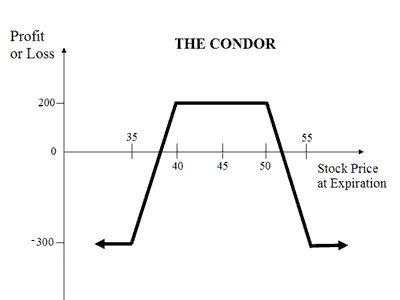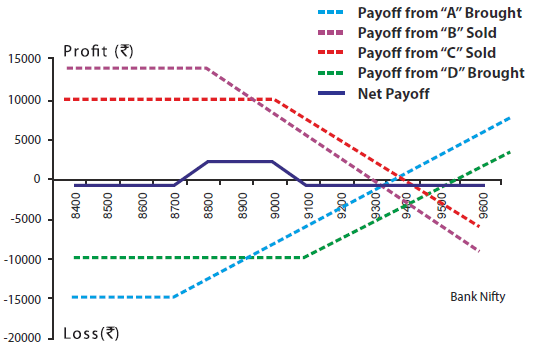 Zerodha (Trading & Demat Account)
Zerodha (Trading & Demat Account)
FREE Equity Delivery and MF
Flat ₹20/trade Intra-day/F&O
 Zerodha (Trading & Demat Account)
Zerodha (Trading & Demat Account)
FREE Equity Delivery and MF
Flat ₹20/trade Intra-day/F&O

|
|
Published on Thursday, April 19, 2018 | Modified on Wednesday, June 5, 2019

| Strategy Level | Advance |
| Instruments Traded | Call |
| Number of Positions | 4 |
| Market View | Neutral |
| Risk Profile | Limited |
| Reward Profile | Limited |
| Breakeven Point |
A Long Call Condor is a neutral market view strategy with a limited risk and a limited profit. The long call condor investor is looking for little or no movement in the underlying.
It is a 4 leg strategy which involves buying 2 ITM Calls and 2 OTM Calls at different strike price with the same expiry date. The strategy is similar as long butterfly strategy with the difference being in the strike prices selected.
Suppose Nifty is currently trading at 10,400. The long call condor strategy can be used if expect very little volatility in the index and market to largely remain range bound. To profit in such a market scenario lets:
| Orders | Example NIFTY Strike Price |
|---|---|
| Buy 1 ITM Call | NIFTY18APR10200CE |
| Sell 1 ITM Call (Higher Strike) | NIFTY18APR10300CE |
| Sell 1 OTM Call | NIFTY18APR10500PE |
| Buy 1 OTM Call (Higher Strike) | NIFTY18APR10800PE |
The Net debit of premium is the maximum possible loss while the maximum profit will be when Nifty is between the strike prices of 2 short calls on expiry.
The Long Call Condor works well when you expect the price of the underlying to be range bound in the coming days. In other words, when the trader is anticipating minimal price movement in the underlying during the lifetime of the options.
Let's take a simple example of a stock trading at Rs 45 (spot price) in June with the lot size of 100 shares in 1 lot. The option contracts for this stock are available at the following premium:
Buy July 35 Call = Rs 11*100 = Rs 1100
Sell July 40 Call = Rs 7 * 100 = Rs 700
Buy July 55 Call = Rs 1 * 100 = Rs 100
Sell July 50 Call = Rs 2 * 100 = Rs 200
Net Debit of Premium = 1100 - 700 + 100 - 200 = Rs 300
Maximum Possible Loss = Net Debit of Premium = Rs 300
Scenario 1: Stock price goes down to Rs 35
At this price all options expires worthless. Thus the net loss is Rs 300 which was paid at the time of buying the strategy.
Scenario 2: Stock price reaches to Rs 55
July 35 Call (Long) = (55-35)*100 = Rs 2000
July 40 Call (Short) = (40-55)*100 = -Rs 1500
July 55 Call (Long) = Rs 0
July 50 Call (Short) = (50-55)*100 = -Rs 500
Net Position = 2000 - 1500 + 0 - 500= Rs 0
Initial Debit: -Rs 300
Maximum Loss: Rs 300 paid as net debit of premium at the time of buying the strategy.
Scenario 3: Stock price remain at Rs 45
July 35 Call (Long) = (45-35)*100 = Rs 1000
July 40 Call (Short) = (40-45)*100 = -Rs 500
Initial Debit: -Rs 300
Net Profit = Rs 1000 - Rs 500 - Rs 300 = Rs 200
In this example, the maximum profit is achieved if the underlying stock price at expiration is anywhere between Rs 40 and Rs 50.
| Spot Price | 8900 |
| Lot Size | 25 |
| Strike Price(Rs ) | Premium(Rs ) | Premium Paid(Rs ) | |
|---|---|---|---|
| Buy 1 Deep ITM Call | 8700 | 580 | 14500 |
| Sell 1 ITM Call | 8800 | -520 | -13000 |
| Sell 1 OTM Call | 9000 | -420 | -10500 |
| Buy 1 Deep OTM Call | 9100 | 380 | 9500 |
| Net Premium | 500 | ||
| Upper Breakeven(Rs ) | Higher Strike price - Net Premium Paid | 8600 |
| Lower Breakeven(Rs ) | Lower Strike price + Net Premium Paid | 9200 |
| Maximum Possible Loss (Rs ) | Net Premium Paid | 500 |
| On Expiry Bank NIFTY closes at | Net Payoff from 1 Deep ITM Call bought (Rs ) 8700 | Net Payoff from 1 ITM Call sold (Rs ) 8800 | Net Payoff from 1 OTM Call sold (Rs ) 9000 | Net Payoff from 1 deep OTM call bought (Rs ) 9100 | Net Payoff (Rs ) |
|---|---|---|---|---|---|
| 8400 | -14500 | 13000 | 10500 | -9500 | -500 |
| 8600 | -14500 | 13000 | 10500 | -9500 | -500 |
| 8720 | -14000 | 13000 | 10500 | -9500 | 0 |
| 8800 | -12000 | 13000 | 10500 | -9500 | 2000 |
| 9000 | -7000 | 8000 | 10500 | -9500 | 2000 |
| 9080 | -5000 | 6000 | 8500 | -9500 | 0 |
| 9200 | -2000 | 3000 | 5500 | -7000 | -500 |
| 9400 | 3000 | -2000 | 500 | -2000 | -500 |

When you are unsure about the direction in the movement in the price of the underlying but are expecting little volatility in it in the near future.
Suppose Nifty is currently trading at 10,400. You expect little volatility in the index and market to largely remain range bound. To profit in such a market scenario, you can buy buy 1 ITM Nifty Call Option at 10,200, sells 1 ITM Nifty Call Option 10,300, sell 1 OTM Call Option at 10,500 and buy 1 OTM Nifty Call Option at 10,800. The Net debit of premium is the maximum possible loss while your maximum profit will be when Nifty is between the strike prices of 2 short calls on expiry.
The maximum risk in a long call condor strategy is equal to the net premium paid at the time of entering the trade. The max risk is when the price of the underlying equal to or below the lower strike price or when the underlying price is equal to or above the higher strike price of Options in trade at expiration time.
The maximum profit in a long call condor strategy is realized when the price of the underlying is trading between the two middle strikes at time of expiration.
Both ITM Calls exercised
Max Profit = Strike Price of Lower Strike Short Call - Strike Price of Lower Strike Long Call - Net Premium Paid
All Options exercised or not exercised
Max Loss = Net Premium Paid
It allows you to profit from range bound underlying at low capital. The profit is high with limited risk exposure.
The maximum profit for the condor trade may be low in relation to other trading strategies but it has a comparatively wider profit zone.
Strike prices selected may have an impact on the potential of profit.
Brokerage and taxes makes a significant impact on the profits from this strategy. The cost of trading increases with number of legs. This strategy has 4 legs and thus the brokerage cost is higher.
Reverse the trade by selling bought Options and buying back short Options.

Add a public comment...

FREE Intraday Trading (Eq, F&O)
Flat ₹20 Per Trade in F&O
|
|